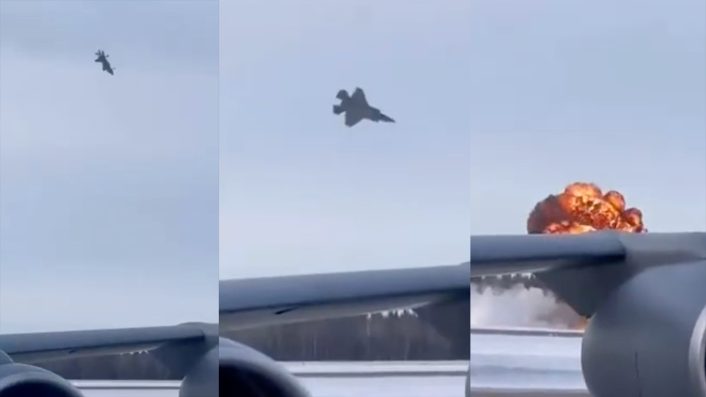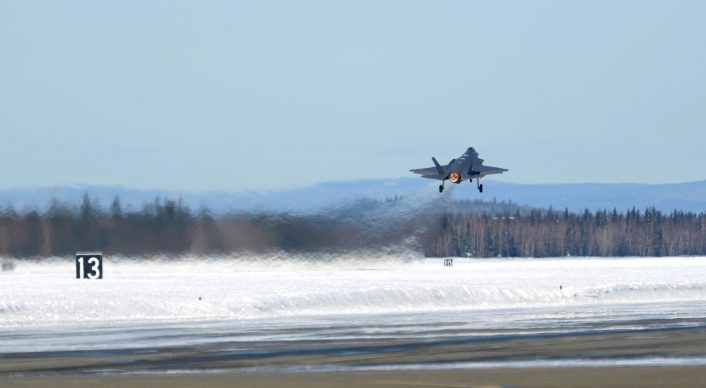PACAF’s investigation found water-contaminated hydraulic fluid iced up and triggered a touchdown equipment breakdown, leading to the loss of an F- 35 A at Eielson AFB.
An Accident Investigation Board (AIB) record released on Aug. 26, 2025, by the U.S. Pacific Air Forces (PACAF) has clarified the situations that brought about the loss of an U.S. Flying Force F- 35 A Lightning II during a training mission at Eielson Air Force Base, Alaska, on Jan. 28, 2025 As we reported back then, the jet crashed within the fencing line of the base, with a video clip revealing the F- 35 rotating in the direction of the ground with its landing equipment expanded.
The aircraft, appointed to the 355 th Fighter Armada of the 354 th Competitor Wing, was destroyed after a stopped working healing attempt, though the pilot securely expelled with only small injuries. According to the press launch concerning the examination, the failure was approximated at $ 196 5 million.
According to the main AIB record , the mishap was activated by hydraulic fluid polluted with water, which iced up in the frigid Alaskan temperature levels and avoided the correct extension of the landing equipment. This malfunction triggered a chain of occasions that inevitably rendered the airplane uncontrollable, leading to the crash.
Takeoff and First Malfunction
The accident occurred quickly before 1 p.m. regional time, throughout a routine training sortie. After launch, the pilot tried to pull back the touchdown equipment, however the nose touchdown gear (NLG) fell short to straighten and stayed canted in between 17 and 25 levels to the left. This abnormality was rapidly identified as a malfunction, and the pilot entered a holding pattern while troubleshooting the issue with the help of the Supervisor of Traveling (SOF) and Lockheed Martin designers which were called by phone.


At the time, temperatures at Eielson were well below cold- with the observed temperature being − 17 ° C (1 4 ° F)– and the aircraft had currently spent considerable time revealed to the cool during pre-flight checks. These conditions played a central function in the failure, as the AIB later figured out.
Attempts to Recenter the Landing Equipment
To correct the problem, the pilot was recommended to carry out touch-and-go maneuvers , in an effort to help realign touchdown gear. On the very first attempt, the nose gear failed to recenter. A 2nd effort, flown at greater rate, partially boosted the scenario, decreasing the cant angle to around 6 levels.
Nonetheless, ice buildup inside the main touchdown gear shows off stopped them from totally expanding. Therefore, the aircraft’s Weight-on-Wheels (WoW) sensing units wrongly signed up that the jet got on the ground, even though it was air-borne. This sensor error caused the trip control system to switch over to the “on ground” flight control legislation, badly interfering with the jet’s handling.
The pilot unexpectedly experienced uncommanded yaw and pitch oscillations. With the airplane rapidly coming to be unmanageable, thinking a perspective with 30 – 40 levels pitch up and a 38 degrees left roll at simply 372 feet above ground degree and a rate of 222 knots, the pilot launched the ejection The getaway system worked as made, and the pilot landed securely nearby.


Airplane Loss and Immediate Feedback
Minutes after ejection, the F- 35 A delayed at an altitude of 2, 665 feet AGL, spiraled uncontrollable and affected the ground with a 116 -degree right bank within the border of Eielson Air Force Base, hence being destroyed by the accident and subsequent fire. Emergency -responders were on scene within one min, reports the AIB.
No injuries to base employees or private citizens were reported, although the incident stood for a major product loss. The ruined airplane, identification number 19 – 5535, was valued at $ 196 5 million, states the solution.
Root Cause Evaluation
The AIB established that the root cause of the collision was hydraulic fluid infected with water, which froze in the severe chilly and prevented the landing gear from totally prolonging. Because the touchdown equipment can not properly seat right into setting, the system transferred incorrect signals to the aircraft’s Weight on Wheel sensing units, bring about the erroneous ground mode activation.
The examination traced the contamination back to upkeep and harmful materials (HAZMAT) management drawbacks, especially not enough manning and regular supervision adjustments. According to the record, hydraulic maintenance at Eielson was executed with inappropriate treatments.


Upkeep workers used less fluid than required because of devices limitations, as a hand cart was utilized rather than a nitrogen servicing cart, and the lines were not sufficiently purged. This left water contamination inside the system, as the AIB figured out water was already in the struts before the maintenance conducted 3 days before the accident.
Additionally, barrels of hydraulic fluid were not properly saved or tracked, and not enough staffing and guidance added to the issue. The AIB highlighted that these failures developed an atmosphere where water seepage into hydraulic systems could go undetected.
Decision-Making and Human Variables
While the technological breakdown was the direct reason for the problem, the AIB also noted contributing human variables Specifically, the choice to continue air-borne repairing with successive touch-and-go maneuvers was brought into question, although the AIB very commended the efforts by all events entailed.
Nevertheless, the board found that the persistence in trying to mechanically recenter the touchdown equipment, rather than getting ready for an emergency landing with the gear misaligned, enhanced the chance of disastrous failure. As a matter of fact, the report discusses that a Lockheed Martin maintenance circular from April 2024, mentioning that WoW sensor problems could cause airplane controllability problems, might have been potentially referenced, and the pilot might have been encouraged to perform an intended full stop touchdown or a controlled ejection rather than a second touch-and-go.


That stated, the report stressed that the pilot was a totally certified and highly skilled F- 35 A critic pilot, with a total of over 2, 700 flight hours, consisting of 555 hours in the F- 35 A. The pilot additionally received a “Good” rating in the area of Flight Leadership and Trainer Performance for demonstrating remarkable skill and expertise.
A Similar Incident
The Jan. 28 collision was not an isolated situation. Just 9 days later, on Feb. 6, one more F – 35 A experienced a comparable nose equipment malfunction, points out the record. In that circumstances, the pilot got a nose wheel equipment risky indication after takeoff, flying for around 40 minutes with the touchdown gear decreased before touchdown uneventfully.
The record indicated the unsafe nose gear sign was because of the uplock missing the roller and rotating the nose wheel 10 degrees to the left in a comparable manner to the collapsed airplane. Furthermore, while landing the nose wheel went from 10 degrees to the delegated 5 levels at touchdown.
Ground testing then confirmed that frozen hydraulic liquid contamination was once more liable. The record wrapped up that it was likely water was currently existing during previous flights, but no breakdowns took place as temperature levels were greater and water did not have time to freeze before launch.